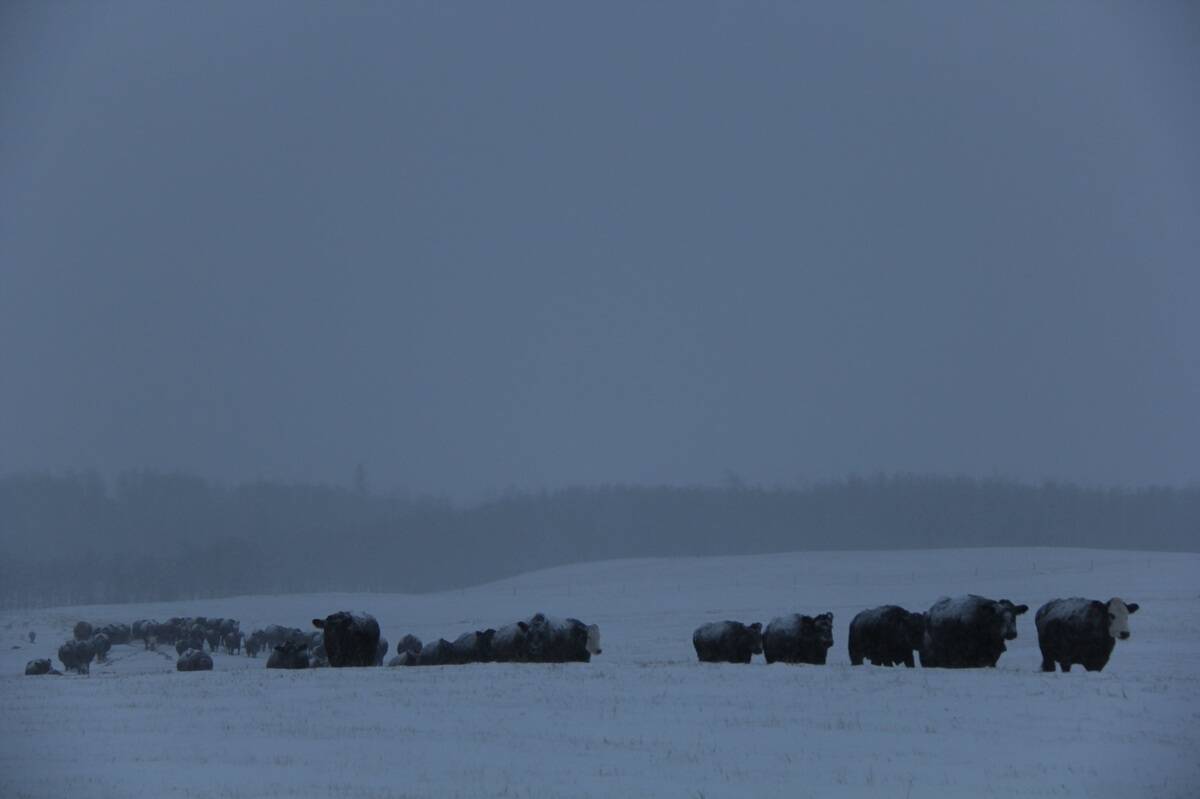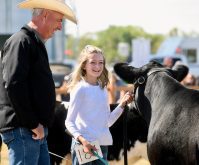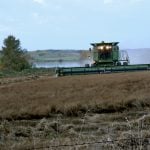The U.S. herd is expanding, while the Canadian beef cattle herd has stabilized. Cattle prices have peaked and producers are now watching to see how far and how fast prices will drop with more pounds of protein available in North America. This will be largely determined by domestic and international demand, which were very strong in 2015, but could soften in 2016. It will be necessary to watch margins carefully and control costs as expansion occurs.
Canadian beef cow inventories stable
Canadian cattle inventories on January 1, 2016 were up 0.3 per cent at 12.0 million head, the first increase since January 2013. The slight increase is driven by higher heifer retention and calf numbers, while beef cow inventories remained steady, and steer and feeder heifers for slaughter were down.
Beef cow inventories were steady, with last year at 3.83 million head. This is the first year without a decline in beef cow herd since 2006. Alberta (+0.8 per cent) and British Columbia (+1.8 per cent) saw larger beef cow numbers while other provinces were down 0.4-2.5 per cent. With cow marketings down 19 per cent in 2015, it was anticipated that beef cow numbers would be up 1.0 to 2.0 per cent. While the increase did not show up in this January report, the steady numbers at least indicate a stable beef cow herd for the first time in 10 years.

Stronger evidence of expansion is shown in heifer retention. Beef heifers held for breeding were up 4.0 per cent at 547,300 head, the highest number since 2008. Interest in expansion was shown in most provinces, with Alberta up 5.2 per cent, Saskatchewan 4.6 per cent, Manitoba 3.4 per cent, Quebec 1.4 per cent, British Columbia 1.2 per cent and Ontario 0.2 per cent. The only exception was the Atlantic provinces, which were down 4.5 per cent.
Combining the beef cows and breeding heifer inventories, total breeding female numbers are up 0.4 per cent or 19,200 head. Heifers represent 14.3 per cent of the breeding herd, up slightly from 13.7 per cent last year. A larger breeding herd is expected to result in a larger calf crop this spring and support production moving forward. Profits in the cow-calf sector in 2015 should support more robust heifer retention in 2016, if weather co-operates. However, this is expected to be tempered by lower fed cattle prices and market volatility.

Feeder and calf supplies outside of feedlots were up slightly by 0.2 per cent or 10,000 head at 4.05 million head, but remain 3.0 per cent or 144,000 head lower than 2014. These are the second-lowest numbers since 2011, meaning feeder supplies remain tight. The 2015 calf crop is up 0.9 per cent head at 3.88 million head. A slightly larger calf crop coupled with the sharp decline in feeder exports since September 2015 should support fed cattle marketings in 2016. However, after seeing an extremely strong feeder basis from September 2015 through February 2016 discouraging feeder exports, a move back to the five- year average has seen more feeders going south in March.
U.S. herd expansion increasing production
U.S. cattle inventories on January 1 were up for the second year to 92 million head, up 3.2 per cent or 2.8 million head from 2015. This is the largest year-over-year increase since 1981, as producers quickly restock following liquidation during the drought years. However, total inventories remain one per cent smaller than 2011 and are anticipated to see further growth in 2016, though at a slower pace as prices experienced a sharp correction this winter.

Beef cow numbers increased 3.5 per cent or one million head to 30.3 million head, the highest level since 2011. Beef replacement heifers were up 3.3 per cent or 198,800 head to 6.3 million head, the highest since 1995. Although the increase in breeding female numbers has been sharp, lower cattle prices and margins at the end of 2015 will likely slow expansion. U.S. beef cow slaughter is up 1.4 per cent in the first quarter of 2016. There are already weather concerns in some regions, which may slow growth further.
The 2015 calf crop was up 2.3 per cent at 34.3 million head, and feeders outside of feedlots were up 5.3 per cent at 25.9 million head. U.S. cattle on feed march 1 were up a modest 0.8 per cent from 2015 and 0.5 per cent from 2014. However, the number of cattle on feed for four months or longer was up 3.4 per cent from 2015 and up 17.4 per cent from 2014. In addition, carcass weights continue to be large. Steer carcass weights this spring have averaged 15 lbs. larger than last year, but jumped from 12 lbs. to 25 lbs. heavier in march. Overall, we are looking at larger U.S. beef production in 2016.
Read Also

Winter cereals on a beef cattle operation
Whether beef farmers and ranchers are grazing into the fall or need feed, winter cereals are worth a look.
As production starts to increase in the U.S., prices will be pressured down. How quickly prices drop will depend not only on how fast supplies increase, but on how consumer demand holds up domestically and internationally.
Canadian beef production steady to higher in 2016
Total beef production (domestic slaughter and live slaughter exports) dropped nine per cent in 2015 to 2.7 million pounds (1.24 thousand tonnes) to be the lowest since 1994. Packers were successful in keeping cattle in Canada last year, with domestic production down only 3.3 per cent, while live slaughter exports were down 32 per cent. This larger proportion of cattle being processed in Canada, along with a lower dollar, supported beef exports. This was in stark contrast to the U.S., where beef exports fell 12 per cent in 2015.

Domestic beef production in the first quarter of 2016 is up 2.0 per cent and is anticipated to be steady to slightly higher for the year, despite fed cattle marketings being down 7.0 per cent in the first quarter. Fed beef production is only down 0.7 per cent with record-large carcass weights. Steer carcass weights have averaged 939 lbs. this spring, up a staggering 60 lbs. from last year. a mild winter and strong animal performance has contributed to the larger weights that are adding to production.

Cow marketings steady in Q1 2016
In 2015, record-high cattle prices were sending signals for herd expansion, as many producers have rebuilt equity and invested in infrastructure over the last couple of years. Canadian cow marketings in 2015 were down 19 per cent overall, with domestic slaughter down 15 per cent and exports down 26 per cent. The Canadian beef cow culling rate dropped in 2015 to 10.6 per cent; while this is below the long- term average of 11 per cent, the chart indicates this is fairly modest in terms of expansion. In 1994 the rate was at 9.0 per cent, while in 1999 and 2000 it was 8.4-9.5 per cent. In fact, the rate was around 10 per cent as recently as 2012 when the herd was stabilizing. a further drop in cow marketings combined with larger heifer retention is needed to move expansion into high gear. However, that does not appear to be happening in 2016. Cow marketings show no sign of slowing down with cow slaughter up 6.0 per cent (6,500 head) and exports down 10 per cent (or 5,300 head) year to date.
Alberta D1,2 cow prices so far in 2016 have traded narrowly between $103-$110/cwt, 16-29 per cent below last year. Large supplies of imported lean manufacturing beef into North america last year are weighing on the cow market. In addition, it appears cows were fed over the winter supporting current slaughter numbers.

Minimal snow cover in Western Canada has producers watching for timely rains this spring, not only for crop germination, but also pasture conditions. This will be particularly noticeable in those areas that were dry last summer.
Prices and profitability
While the U.S. market peaked in November 2014, the Canadian market was supported by a lower exchange rate throughout last year. In 2015, alberta fed steer prices were up 19 per cent at $183/cwt, 850-lb. steers were up 22 per cent at $243/cwt, 550-lb. steers were up 25 per cent at $305/cwt and D1,2 cows were up 19 per cent at $132/cwt.

Cash margins for feedlots turned negative in September 2015, pressuring calf prices throughout the fall run. Alberta 550-lb. steer calves made a low of $252/cwt in December, before rebounding in the new year, but have fallen again in March to average $252/cwt. As the shine came off prices in the fourth quarter of 2015, many producers felt the impact. It is easy to get used to those record-high prices. Cow-calf producers continue to enjoy record-high profitability, but producers should be watching margins and controlling costs moving forward. Investments in expensive breeding stock can impact cost of production for years to come.
Cattle prices have moved lower this spring, when we typically see a spring rally, as the dollar has moved from 69 cents in early January to 77 cents in March. This is concerning but does not yet call for a counter-seasonal market. The U.S. fed cattle market has ranged between US$132-$139/cwt, with the exchange rate being the major driver for the Canadian market so far in 2016. Despite cut-out values averaging only 3.0 per cent below last year, Alberta fed cattle prices have averaged 10 per cent below 2015 as packers have regained some leverage and margin. A loss of leverage in the cow-calf and feedlot sectors is one of the first things that occurs when the market turns. This contributed to the large price drops in the fourth quarter, but may mean that the largest declines are behind us.
Fifty per cent trim has been a roller-coaster this spring, adding to the volatility in the fed cattle market. Record- large carcass weights contributed to excessive volumes all winter, keeping pressure on prices, which dropped to $53/ cwt in December the lowest prices since March 2008. However, a significant adjustment occurred in March with prices rebounding to $110/cwt to be steady with last year. Continued large carcass weights will see continued uncertainty in the 50 per cent trim and fed cattle market.
Replacement ratios
Replacement ratios show how much higher feeder cattle prices are per pound of fed cattle. The lower the ratio, the fewer dollars a feedlot needs to replace an animal. Conversely, a high ratio implies the feedlot must pay more per pound to replace an animal. Consequently, a higher ratio has negative implications on feedlot profitability, if feed costs are constant. Replacement ratios peaked in the third quarter of 2015 and have since dropped back to levels similar to lower than last year in the first quarter of 2016.
In addition to lower cattle costs, feed prices have softened with the U.S. corn-planting intentions surprisingly large at 93.6 million acres compared to pre-report estimates of 89-91 million acres. Now, a lot can and will happen with acres planted as farmers adjust plans, but at this point it appears there will be ample feed in 2016, pressuring prices lower. However, all of that pressure is coming from the U.S. as Canadian barley production is projected to increase a modest 2.0 per cent to 8.4 million tonnes.

In March, Lethbridge barley prices were up 3.0 per cent from last year at C$213/tonne and Ontario corn was down 4.0 per cent at C$187/tonne, while Omaha corn prices were down 9.0 per cent at C$191/tonne (in barley equivalents or US$3.45/bu.). This widened Canada’s feeding disadvantage.
Demand remains strong
Retail beef prices stabilized in the second half of 2015 and have been steady since. Per capita consumption is projected to be down 4.5 per cent. The Retail Beef Demand Index is an indicator of consumer willingness to pay by evaluating per capita consumption and deflated retail prices. Since 2011, the index has rebounded from the low made following the global financial crisis, and is projected to be up 7.0 per cent in 2015 to 124 (Index 2000=100). This is the strongest demand in 25 years, since 1989. The uptrend of the demand index in the past five years shows that beef demand has been resilient to high prices, but it remains uncertain how demand will hold up in 2016 with larger pork and poultry supplies.

Nominal retail beef prices in 2015 averaged $19.67/ kg, up 15 per cent from 2014, while pork was up 12 per cent at $13.50/kg and chicken up 5.0 per cent at $7.61/kg. Beef has increased from being two times the price of poultry (historic average), to being 2.75 times the price of poultry in February 2016. But consumers are not turning to poultry. Per capita poultry consumption has been stable since 2001 around 37 kgs/person. Given the saturated poultry market, consumers are looking at alternative protein options like Greek yogurt and hummus. Another option is pork. Throughout 2015, beef remained at the historic average of 1.4 times the price of pork, but as pork prices came down in 2016, this has increased to 1.6 times the prices of pork in February 2016.
The International Demand Index for Canadian beef has been supported by a lower exchange rate, as well as the economic recovery in the U.S. and strong demand from China, which supported exports last year. International demand was up 13 per cent in 2015. Beef exports in 2015 were up 1.0 per cent in volume at 322,000 tonnes and 15 per cent in value at $2.2 billion. In contrast to the U.S., where a strong dollar and disruptions at West Coast ports reduced exports in 2015, a weaker Canadian dollar and direct access to mainland China supported Canadian beef exports. In the first half of 2015, Chinese official’s anti-smuggling campaign to reduce grey channel pork imports also reduced volumes of beef through the grey channel. Canada was able to quickly redirect trade through official channels directly to mainland China. Consequently, China became the second-largest market for Canadian beef in 2015. However, total exports to the Asian region were steady as China pulled product previously going to other countries. The U.S. remains Canada’s top market, accounting for 71.4 per cent of total beef exports, followed by mainland China (10 per cent), Mexico (6.0 per cent), Japan (4.5 per cent), and Hong Kong (3.3 per cent).
From January to February 2016 beef exports were up 6.0 per cent in volume but down 3.0 per cent in value as the higher Canadian dollar impacted values. Volumes were up to the United States (9.7 per cent), Hong Kong (32 per cent), China (36 per cent), Japan (7.7 per cent) and South Korea (25 per cent).
















